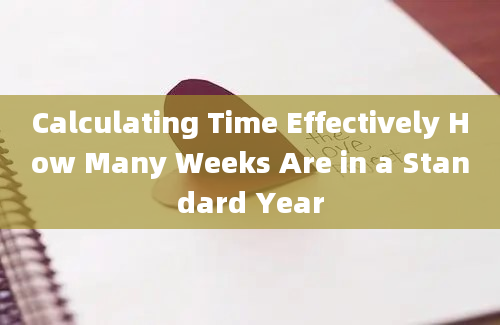Calculating Time Effectively: How Many Weeks Are in a Standard Year

Understanding the passage of time is crucial for planning and organizing various aspects of life, from personal schedules to professional projects. One common question that arises is, "How many weeks are in a standard year?" This seemingly simple query has a straightforward answer, but it also involves a deeper understanding of how our calendar system works.
The Standard Year: Weeks and Days
A standard year, also known as a common year, consists of 365 days. To determine the number of weeks in a year, we divide the total number of days by 7 (the number of days in a week):
\[ \text{Number of weeks} = \frac{365 \text{ days}}{7 \text{ days/week}} \approx 52.14 \text{ weeks} \]
This calculation results in approximately 52 weeks and 1 day. Therefore, a standard year is typically considered to have 52 weeks, with one extra day.
Leap Years: An Exception
It's important to note that every four years, we have a leap year, which adds an extra day to the year, making it 366 days. This adjustment is necessary to align our calendar with the Earth's orbit around the Sun. In a leap year, the calculation changes slightly:
\[ \text{Number of weeks in a leap year} = \frac{366 \text{ days}}{7 \text{ days/week}} \approx 52.28 \text{ weeks} \]
This results in approximately 52 weeks and 2 days.
Historical Context and Calendar Systems
The Gregorian calendar, which is the most widely used civil calendar today, was introduced by Pope Gregory XIII in 1582. It refined the earlier Julian calendar to improve the accuracy of the year's length. The Gregorian calendar accounts for the leap year every four years but excludes centurial years that are not divisible by 400. For example, the year 1900 was not a leap year, but the year 2000 was.
For more detailed information on the history and mechanics of the Gregorian calendar, you can refer to the [U.S. Naval Observatory](https://www.usno.navy.mil/USNO/time/masterclock/leapyear).
Practical Implications
Understanding the number of weeks in a year has practical implications for various fields:
1. Project Management: Accurate time estimation is crucial for project planning and execution.
2. Finance: Annual budgets and financial forecasts often rely on precise time calculations.
3. Education: Academic calendars are designed based on the number of weeks in a year.
4. Healthcare: Medication schedules and treatment plans may be planned on a weekly basis.
Conclusion
In summary, a standard year comprises 52 weeks and 1 day, while a leap year consists of 52 weeks and 2 days. This knowledge is essential for effective time management and planning in various aspects of life.
Frequently Asked Questions (FAQs)
Q1: How many weeks are in a standard year?
A1: A standard year has 52 weeks and 1 day.
Q2: Why do we have leap years?
A2: Leap years are necessary to align our calendar with the Earth's orbit around the Sun, compensating for the approximately 11minute annual difference.
Q3: How many days are in a standard year?
A3: A standard year consists of 365 days.
Q4: How many weeks are in a leap year?
A4: A leap year has 52 weeks and 2 days.
Q5: What is the Gregorian calendar?
A5: The Gregorian calendar is the most widely used civil calendar, introduced in 1582 to improve the accuracy of the year's length.
Q6: How does the Gregorian calendar handle leap years?
A6: The Gregorian calendar includes a leap year every four years but excludes centurial years not divisible by 400.
Q7: Why is the extra day in a leap year added in February?
A7: February was chosen because it was the last month of the Roman calendar and traditionally had a variable number of days.
Q8: How does knowing the number of weeks in a year help in project management?
A8: Accurate time estimation aids in planning, scheduling, and ensuring project milestones are met on time.
Q9: Can a year ever have exactly 53 weeks?
A9: Yes, in certain calendar configurations, a year can start and end on the same day of the week, resulting in 53 weeks.
Q10: Where can I find more information about the history of calendars?
A10: You can visit the [U.S. Naval Observatory](https://www.usno.navy.mil/USNO/time/masterclock/leapyear) for comprehensive information on the history and mechanics of various calendar systems.










